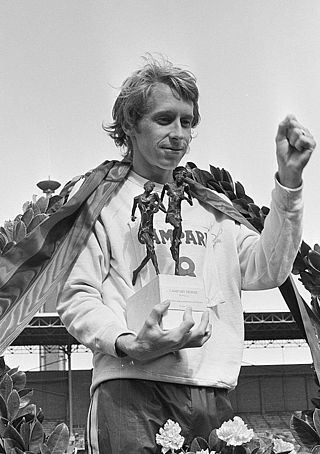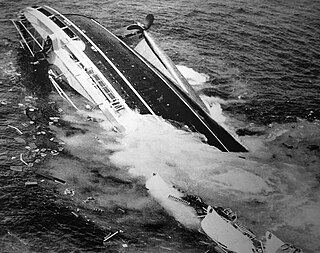
The marathon is a long-distance foot race with a distance of 42.195 km, usually run as a road race, but the distance can be covered on trail routes. The marathon can be completed by running or with a run/walk strategy. There are also wheelchair divisions. More than 800 marathons are held worldwide each year, with the vast majority of competitors being recreational athletes, as larger marathons can have tens of thousands of participants.

The Boston Marathon is an annual marathon race hosted by several cities and towns in greater Boston in eastern Massachusetts, United States. It is traditionally held on Patriots' Day, the third Monday of April. Begun in 1897, the event was inspired by the success of the first marathon competition in the 1896 Summer Olympics. The Boston Marathon is the world's oldest annual marathon and ranks as one of the world's best-known road racing events. It is one of six World Marathon Majors. Its course runs from Hopkinton in southern Middlesex County to Copley Square in Boston.

In many sports, a competition number is used to identify and differentiate the competitors taking part in a competitive endeavour. For example, runners in a race may wear prominent competition numbers so that they may be clearly identified from a distance. Competition numbers are differentiated from uniform numbers in that the former are used for a specific event while the latter persist over time through multiple events, seasons, or sometimes an entire career.

William Henry Rodgers is an American runner, Olympian, and former record holder in the marathon. Rodgers is best known for his four victories in both the Boston Marathon, including three straight from 1978 to 1980, and 4 straight wins in the New York City Marathon, between 1976 and 1979.

Kathrine Virginia Switzer is an American marathon runner, author, and television commentator.
Semple is a surname of Scottish origin. Notable people with the name include:
Nina Kuscsik is a retired long-distance runner from the United States, who has participated in over 80 marathons. In 1972, she became the first woman to officially win the Boston Marathon. After Beth Bonner, Kuscsik became the second American woman to complete a marathon in under three hours, running a time of 2:56:04 at the 1971 New York City Marathon.

Roberta Louise Gibb is an American former runner who was the first woman to have run the entire Boston Marathon (1966). She is recognized by the Boston Athletic Association as the pre-sanctioned era women's winner in 1966, 1967, and 1968. At the Boston Marathon, the pre-sanctioned era comprised the years from 1966 through 1971, when women, who under AAU rules could not compete in the Men's Division, ran and finished the race. In 1996 the B.A.A. retroactively recognized as champions the women who finished first in the Pioneer Women's Division Marathon for the years 1966–1971.
Ron Daws was a runner and 1968 Summer Olympics men's marathon athlete. Born in Minneapolis, Minnesota, he also competed at the 1967 Pan-American Games marathon and finished first in the National AAU Marathon also in 1967 on June 11.
Maureen "Moe" Wilton is a former Canadian long-distance runner who is recognized by the International Association of Athletics Federations as having set a world best in the marathon on May 6, 1967, with a time of 3:15:23 in Toronto, Ontario, Canada. Wilton, who started running when she was nine years old, was 13 when she set the mark; it was her first marathon and run on an unpaved Eastern Canadian Marathon Championships course. Her time broke the previous record, set in 1964, by more than four minutes.
The 2013 Boston Marathon was the 117th running of the annual marathon race in Boston, United States, which took place on April 15, 2013. Organized by the Boston Athletic Association (B.A.A.), it hosted the second of the World Marathon Majors to be held in 2013 with over 23,000 runners participating. Lelisa Desisa won the men's race with a time of 2:10:22, and Rita Jeptoo won the women's with a time of 2:26:25. Hiroyuki Yamamoto won the men's wheelchair race in 1:25:32 and Tatyana McFadden won the women's in 1:45:25.

The 2017 Boston Marathon was the 121st running of the Boston Athletic Association's mass-participation marathon. It took place on Monday, April 17. Geoffrey Kirui won the men's race in 2:09:37 and Edna Kiplagat won the women's race in 2:21:52.
Sara Mae Berman is an American marathon runner. Berman won the Boston Marathon as an unofficial winner from 1969 to 1971 as women were not allowed to compete until 1972. At subsequent Boston Marathons, Berman had a fifth-place finish in both 1972 and 1973. Berman's wins were made official by the Boston Athletic Association in 1996. Outside of Boston, Berman finished third at the 1971 New York City Marathon. In 2015, she was inducted into the Road Runners Club of America Hall of Fame. Berman is the daughter of Saul O Sidore and May Blum Sidore Gruber.

The 2019 New York City Marathon was the 49th running of the annual marathon race held in New York City, United States, which took place on November 3, 2019. The men's race was won by Kenyan Geoffrey Kamworor in a time of 2:08:13. The women's race was won in 2:22:38 by Kenyan Joyciline Jepkosgei, making her official debut at the distance. The men and women's wheelchair races, were won by American Daniel Romanchuk (1:37:24) and Switzerland's Manuela Schär (1:44:20), respectively. A total of 53,508 runners finished the race, comprising 30,794 men and 22,714 women.
Allan Steinfeld was the president of the New York Road Runners and race director of the New York City Marathon from 1994 to 2005. During his executive career, Steinfeld was also the technical director of the New York City Marathon and the NYRR's chief executive officer during the 1980s. In 2009, Steinfeld received the Abebe Bikila Award from the NYRR. Outside of the NYRR, Steinfeld was a co-establisher of the Association of International Marathons and Distance Races in 1982.
The Avon International Marathon was an annual women's marathon event that was held at various locations from 1978 to 1984. Sponsored and organised by Avon Products, a beauty and household goods company, it was the longest distance race within the Avon International Women's Running Circuit, which was created with the aim of promoting elite and grassroots road running for women. The circuit was headed by former runner Kathrine Switzer, whose efforts had led to the formal acceptance of women at the Boston Marathon.

Harry A. Trask (1928–2002) was an American photojournalist. He received the 1957 Pulitzer Prize for Photography for his reportage of the Italian cruise ship SS Andrea Doria sinking into the Atlantic Ocean.
Roger Derek Robinson is a New Zealand academic, essayist, editor, runner, sportswriter, and sports commentator. Robinson earned his Ph.D. from the University of Cambridge and moved to New Zealand in 1968, where he became an English professor at Victoria University of Wellington. He has expertise in New Zealand literature and literature and journalism relating to running. He has written and edited several books about running, including When Running Made History (2018), and received awards for his sporting journalism. As a runner, he competed internationally from 1966 to 1995 and won marathons at a Masters level in the 1980s.
The 1978 Avon International Marathon was the first edition of the Avon International Marathon, and took place on March 19, 1978, in Atlanta, Georgia, in the United States. It was a women-only marathon which had been put on to showcase female talent over the distance, which at the time did not feature for women at the Olympic Games. The race was sponsored by Avon Products, who had covered the traveling expenses for some of the world's best female marathon runners to take part. The race was won by Marty Cooksey of the United States, a relative unknown, in a time of 2:46:16.
William Thomas Cloney was an American athletics administrator who was the race director of the Boston Marathon from 1946 to 1982 and president of the Boston Athletic Association from 1964 to 1982.










